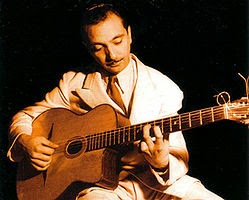The Practice--Jazz Medicine (excerpt from Whole Music Soul Food for the Mind Body Spirit)
 |
| Django Reinhardt, Wikipedia |
(This excerpt comes from chapter 12, "Catching the Coletrane" of Whole Music Soul Food for the Mind Body Spirit)
Jazz Medicine
The
story of jazz contains just as many tragedies as it does moments of
elation. Jazz musicians in general have
personal history and early African-American jazz players in particular, carried
the added weight of injustice, racism, illness, and addiction in the
competitive music industry. Societies in
the west color any genre of music hailing from Africa with prejudices. Early jazz as it emerged in the US and
arrived in America in the late 19th and early 20th centuries was viewed as a
novelty in some cases, and primal in other cases giving listeners the license
to adopt destructive practices (consumption of alcohol, loosening of sexual
morals and exploring the seedier side) as portrayed in Jeffrey H. Jackson’s
book, Making Jazz French.
However,
even local-grown European musicians harnessed the power of jazz to bring
healing to their lives. Belgium-born
gypsy Django Reinhardt lost two of his fingers in a fire when he was a
teenager. Despite his loss, which was
greater than disfigurement, Reinhardt mastered guitar with his remaining
fingers while creating a new style of playing that launched him into gypsy
swing or French jazz fame along with violinist Stéphane Grappelli. And all of this happened between the two
world wars and during the second one, not an easy time for gypsies.
However,
when we listen to Reinhardt swing with his quintet, we don’t think about tragic
events or WWII. We lose ourselves in the
jangling guitar, the gypsy violin, and the danceable rhythms. It’s as if the heavens opened and gave the
gift of jazz to humankind to endure hard times, from Latin jazz players in
Brooklyn to early African American jazz pioneers, and to the European players
on the wrong side of a war. It’s true
that some types of jazz carry blue notes and sentiments that add to catharsis,
but with jazz ballads we can empathize with a singer whose situation matches
our own experiences. With swing, samba,
or other types of Latin jazz we lose ourselves when we get up and dance.
Jazz
vocalist Trish Hatley shared such a moment in a 2012 e-mail interview. As Hatley drove on a highway in Phoenix,
feeling in a funk, she tuned her radio to a jazz station playing Brazilian
music and after hearing songs by Jobim, Karin Allison and Diana Krall. Hatley’s elation caused her to pull her car
into a parking lot where she climbed out and danced.
I climbed back into my car and for the short drive home I talked to myself about the need for music in my life. How have I abandoned it lately? It is such an up-lifter, a mood-changer…I would have worked myself out of this frump if I had used music to elevate my mood, my life. I woke this morning and put on another Brazilian favorite Elaine Elias…again I danced and moved all over the house, smiling and singing for over fifteen minutes until I had to go. This stuff is good! Music should be a staple in everyone’s life…whatever their flavor.”
I have been there too, so depressed that I couldn’t get out of my head then I walked into a cafe playing jazz and suddenly my mood shifted. However, the difference between a jazz musician such as Hatley and me is she feels the music inside out because she has recorded some of the jazz standards she hears on the radio on her own seven recordings. In addition, Hatley’s mother (a bassist) played in swing bands when Trish was in utero.
“My mother played music up until her eighth month of pregnancy with me. I truly believe that this had a total effect on me. I joke about how “I came out swinging.” But it isn’t a joke…it is reality. Music that swings absolutely moves me physically. My mother was playing in a big band then...While she wasn’t a fancy bass player she swung so hard that it was totally enough. That is the gift she gave me. I have the total need to feel that swing…it has got to swing! It is cellular, it is totally physical!”
While I don’t own any of Hatley’s swing albums, her interpretation of jazz standards that appear on her On the Quiet Side dazzle. She shaped the melodies of Hoagy Carmichael’s I Get Along without You Very Well, Ivan Lins Love Dance, and Billy Strayhorn’s Lush Life (songs we hear often on jazz recordings) by infusing her own feelings into the songs. However, Hatley’s version of Michel Legrand’s You Must Believe in Spring causes my eyes to mist every time I hear her sing it. Hatley experienced the song on an even deeper level.
“So much of it is about the melody with its luscious chord changes, the tempo, and space within the notes. This can all be felt physically. Then when you add the lyrics, if you can relate to them, the depth of it can be so very heartfelt that the gift is, you transfer this to your audience. It’s so beautiful how just a chord change or one line out of a song can literally knock you over. Even as I write this and feel this thought, I’m placing both hands over my heart…it’s heartfelt.”
copyright 2013 Patricia Herlevi



Comments
Post a Comment